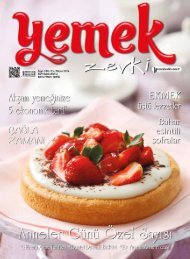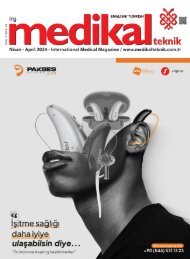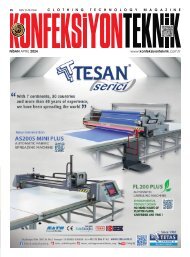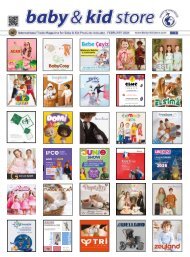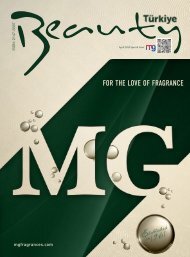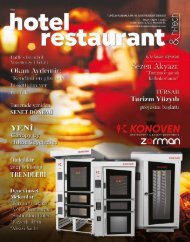You also want an ePaper? Increase the reach of your titles
YUMPU automatically turns print PDFs into web optimized ePapers that Google loves.
İNCELEME<br />
67<br />
Dosing in [ml/kg] implicates a system that is<br />
adding an amount of chemicals in the impregnating<br />
bath proportional to the weight of<br />
fabric. A change of speed and/or a change<br />
of fabric will immediately adapt the amount<br />
of chemicals in order to reach the desired<br />
amounts of chemicals on the fabric specified<br />
by the recipe in [ml/kg].<br />
All systems that exist worldwide belong to one<br />
of the two categories specified hereunder:<br />
- the dosing “related to the fabric”<br />
- the dosing “related to the feeding”<br />
Both systems are dosing in [ml/kg] and thus<br />
dosing related to the fabric. They only differ<br />
in the way how they calculate the necessary<br />
amounts of chemicals. The system “dosing<br />
related to the fabric” is calculating the amounts<br />
of chemicals proportional to the passing fabric,<br />
whereas the system “dosing related to the feeding”<br />
is calculating the amounts of chemicals<br />
related to the used amount of liquid. In the end,<br />
provided the systems are fitted with the needed<br />
technical items, the correct software and a perfect<br />
setting, both systems will give an identical<br />
outcome of the needed [ml/kg] on the fabric.<br />
Şekil 4<br />
Fig 4<br />
Şekil 5<br />
Fig 5<br />
2.1. Dosing related to the fabric<br />
The most common dosing system without any<br />
doubt is the dosing “related to the fabric”. With<br />
this system the software will deliver the needed<br />
amount of chemicals into the impregnating<br />
unit proportional to the amounts of fabrics. On<br />
the same time water is added by an automatically<br />
level control device to assure a constant<br />
volume of the impregnating compartment.<br />
The kinds of dosing devices are many and<br />
discussing all of them would go beyond the<br />
constraints of this article. Most used dosing<br />
devices are:<br />
- dosing by volume in time<br />
- dosing by volume in meter of passing cloth<br />
- dosing by volume with impulses<br />
In all following examples we just will refer to<br />
pumps and water metering systems controlled<br />
by impulses.<br />
The principle of such a “dosing related to the<br />
fabric” is visible as a sketch in fig.4 and fig.5<br />
fig.4 is a system equipped with a circulating<br />
system with mixing vessel for water and chemicals.<br />
In fig.5 water and chemicals are directly<br />
injected in a circulating system. The advantage<br />
of a mixing vessel is the optical control and<br />
an easy maintenance and control of the dosing.<br />
On the other hand, a system as fig.5 will<br />
kontrol sağlaması ve dozajlamanın bakımını ve<br />
kontrolünü kolaylaştırmasıdır.<br />
Öte yandan, şekil 5’teki bir sistem, emprenye<br />
sıvısının çok daha düşük bir hacmine sahip<br />
olacaktır. Düşük hacimlerin avantajı, daha<br />
kısa tepki süreleridir.<br />
Şekil 6<br />
Fig 6<br />
TEKSTİL & TEKNİK | KASIM | NOVEMBER | <strong>2020</strong>



